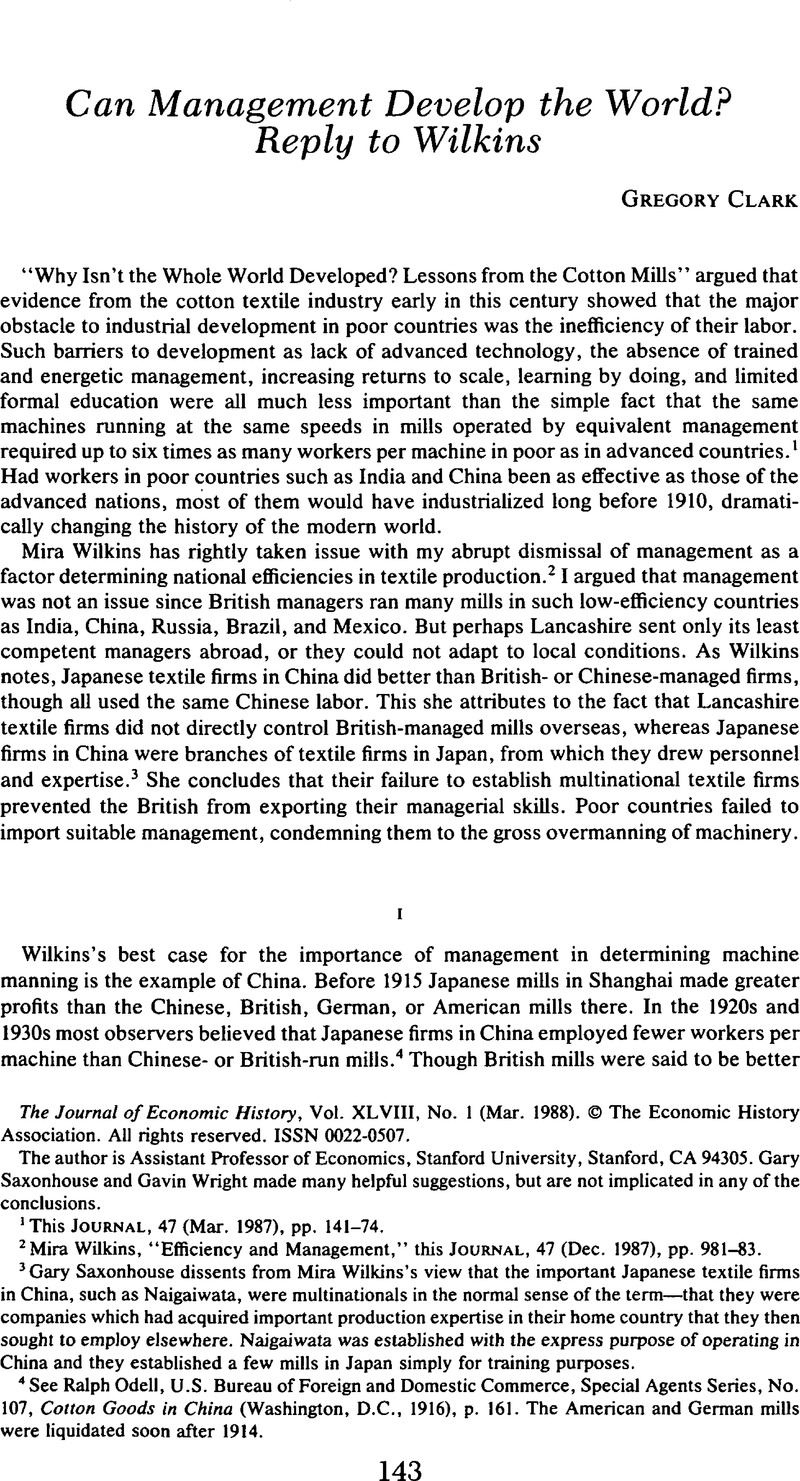Article contents
Can Management Develop the World? Reply to Wilkins
Published online by Cambridge University Press: 03 March 2009
Abstract

- Type
- Notes and Discussion
- Information
- Copyright
- Copyright © The Economic History Association 1988
References
1 This Journal, 47 (03 1987), pp. 141–74.Google Scholar
2 Wilkins, Mira, “Efficiency and Management,” this Journal, 47 (12 1987), pp.981–83.Google Scholar
3 Gary Saxonhouse dissents from Mira Wikins's view that the important Japanese textile firms in China, such as Naigaiwata, were multinationals in the normal sense of the term—that they were companies which had acquired important production expertise in their home country that they then sought to employ elsewhere. Naigaiwata was established with the express purpose of operating in China and they established a few mills in Japan simply for training purposes.
4 See Odell, Ralph, U.S. Bureau of Foreign and Domestic Commerce, Special Agents Series, No. 107, Cotton Goods in China (Washington, D.C., 1916), p. 161. The American and German mills were liquidated soon after 1914.Google Scholar
5 Moser, Charles K., The Cotton Textile Industry of Far Eastern Countries (Boston, 1930), p. 66.Google Scholar
6 Pearse, Arno S., The Cotton Industry of Japan and China (Manchester, 1929), p. 161.Google Scholar Moser noted that “the Japanese mills in China are managed almost exactly as the mills in Japan.” Despite British mills in China not being directly controlled by Lancashire firms, he also noted that the British mills “might be a little bit of Lancashire set down on the far shores of Cathay.” Moser, , The Cotton Textile Industry, p. 66.Google Scholar
7 The data on spindles, workers, and yarn outputs per day are from Fang, Hsien-t'ing (Fong, H. D.), Cotton Industry and Trade in China (Tientsin, 1932), table in Back Pocket, “Revised List of Cotton Mills, 1931”;Google ScholarMoser, , The Cotton Textile Industry, pp. 60–63;Google ScholarPearse, , The Cotton Industry in Japan and China, pp. 154–56.Google Scholar
8 Chinese mills outside Shanghai were often isolated enterprises which typically had more workers per spindle than those in established textile centers. In some cases these mills also ginned their own locally grown cotton, inflating the measured labor force per spindle.
9 In 1929 Japanese mills in Japan produced the same weight of yarn at a given count in a day of 20 hours as did Japanese mills in China in a day of 22 hours. Chinese mills in Shanghai produced about the same weight per spindle per day at a given count as did Japanese mills in Shanghai, but Chinese mills elsewhere (in 1931) attained only about 80 percent of the daily output per spindle of mills in Shanghai. The direct estimates of counts spun are from Chao, Kang, The Development of Cotton Textile Production in China (Cambridge, Mass., 1977), p. 129CrossRefGoogle Scholar; Pearse, , The Cotton Industry of Japan and China, p. 123–25Google Scholar; Reynolds, Bruce L., “The Impact of Trade and Foreign Investment on Industrialization: Chinese Textiles, 1875–1931” (PhD. dissertation, University of Michigan, 1975), appendix C, pp. 261–72.Google Scholar
10 Pearse, , The Cotton Industry of Japan and China, p. 163.Google Scholar
11 In both Japan and Shanghai women were about 80 percent of the mill labor force.
12 Pearse, , The Cotton Industry of Japan and China, pp. 77, 85–86.Google Scholar
13 In the South, average-practice mills in 1912 had about 200 spindles per worker spinning 20s yam, compared to 40 spindles per worker in Japanse mills in Shanghai in 1930. U.S. Tariff Board, Cotton Manufactures (Washington, D.C., 1912), vol. 2, pp. 519–26, 804–8.Google Scholar
14 Rutnagur, S. M., Bombay Industries: The Cotton Mills (Bombay, 1927), pp. 370–74, gives the wage billGoogle Scholar. Odell, Ralph, U.S. Bureau of Foreign and Domestic Commerce, Special Agents Series, No. 124, Cotton Goods in British India, Part I (Washington, D.C., 1916), p. 41, reports the salaries of British managers in IndiaGoogle Scholar. U.S. Tariff Board, p.409, gives the total salary payments for the office staff in the most efficient Lancashire mill examined in 1912 as $6,300, which is the same or less than British staff in India would be paid.Google Scholar
15 See Odell, Ralph, U.S. Bureau of Foreign and Domestic Commerce, Special Agents Series, No. 157, Cotton Goods in British India, Parts V, VI (Washington, D.C., 1918), pp. 34–35.Google Scholar
16 Clark, , “Why Isn't the Whole World Developed?” table 4, p. 152.Google Scholar
17 Saxonhouse, Gary and Wright, Gavin, “Rings and Mules around the World: A Comparative Study in Technological Choice,” in Saxonhouse, Gary and Wright, Gavin, eds., Technique, Spirit and Form in the Making of the Modern Economies (Greenwich, Conn., 1984), p. 292.Google Scholar
18 Rutnagur, , Bombay Industries, p. 37.Google Scholar
19 Oates, Mary, “Locational Patterns in Southern Textile Mills, 1880–1920,” in Okochi, Akio and Yonekawa, Shin-Ichi, eds., The Textile Industry and Its Business Climate (Tokyo, 1982), p. 239.Google Scholar
20 Reynolds, , The Impact of Trade and Foreign Investment, pp. 138–39.Google Scholar
21 Pearse, , The Cotton Industry of Japan and China, p. 127–28;Google Scholar and Moser, , The Cotton Textile Industry, p. 99.Google Scholar
22 Moser, , The Cotton Textile Industry, p. 115.Google Scholar
23 Gandhi, M. P., The Indian Cotton Textile Industry (Bombay, 1937), appendix 1, p. viii, 101.Google Scholar
24 Rutnagur, , Bombay Industries, p. 597.Google Scholar
25 Morris, Morris D., The Emergence of an Industrial Labor Force in India (Berkeley, 1965), pp. 92–96, 114–15;Google ScholarMoser, , The Cotton Textile Industry, p. 142–44.Google Scholar
- 4
- Cited by


